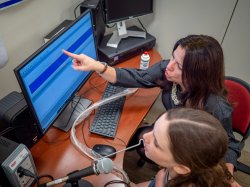
View Profile Page

Elaine Hitchcock
Chairperson, Communication Sciences and Disorders, College for Community Health
- Office:
- 1515 Broad Street 2174
- Email:
- hitchcocke@montclair.edu
- Phone:
- 973-655-7355
- Degrees:
- B.A., Montclair State University
- M.A., Montclair State University
- Ph.D., New York University
- vCard:
- Download vCard
Profile
Elaine Russo Hitchcock is a professor in the Department of Communication Sciences and Disorders at Montclair State University. Dr. Hitchcock is a certified speech-language pathologist with over 20 years of clinical experience working with multiple clinical populations including many individuals with speech sound disorders, motor speech disorders, and voice disorders. At the Montclair State University-Clinical Biofeedback Lab, she conducts research investigating the effectiveness of visual biofeedback techniques, including ultrasound, visual-acoustic and electropalatographic (EPG) biofeedback, as a form of intervention for individuals with communication disorders. Dr. Hitchcock uses biofeedback to help individuals visualize subtle or unconscious speech processes with the goal of bringing them under conscious control. To date, Dr. Hitchcock and her team have successfully used visual biofeedback for treating speech sound disorders, motor speech disorders, accent reduction and voice disorders. Several research projects in the Clinical Biofeedback Lab are funded by the National Institute on Deafness and Other Communication Disorders. If you are interested in learning more about Dr. Hitchcock’s research, please visit the MSU-CBL website at https://sites.google.com/view/msu-cbl/home.
Recent Publications:
McCabe, P., Beiting, M., Hitchcock, E. R., Maas, E., Meredith, A., Morgan, A. T., ... & Grigos, M. I. (2024). Research Priorities for Childhood Apraxia of Speech: A Long View. Journal of Speech, Language, and Hearing Research, 1-14. https://doi.org/10.1044/2024_JSLHR-24-00196
Swartz, M., Hitchcock, E.R., Leece, M., Herbst, B., & Preston, J. (2024). Caregiver and Child Perspectives of Wellbeing in School-Age Children with Childhood Apraxia of Speech. International Journal of Speech-Language Pathology, 1-14. https://doi.org/10.1080/17549507.2024.2364808
Hitchcock, E.R., Koenig, L.L., & Ochs, L. (2024). Examining Speech Perception of Non-Errored Pronunciations in Children with Speech Sound Disorders. In Proc. 13th Intl. Seminar on Speech Production, Haskins Press.
McAllister, T., Preston, J.L., Ochs, L., Hill, J., & Hitchcock, E.R. (2024). Comparing online versus laboratory measures of speech perception in older children and adolescents. PLoS ONE 19(2): e0297530. https://doi.org/10.1371/journal.pone.0297530.
Benway, N. R., Preston, J. L., Salekin, A. Hitchcock, E., & McAllister, T. (2024). Evaluating Acoustic Representations and Normalization Techniques for Rhoticity Classification in Children with Speech Disorders. JASA Express Letters. 4 (2): 025201. https://doi.org/10.1121/10.0024632
Hitchcock, E.R., Swartz, M., Cabbage, K.L. (2023). Speech perception performance profiles of school-age children with childhood apraxia of speech, speech sound disorder, and typical development. Journal of Speech, Language, and Hearing Research, 1-15. https://doi.org/10.1044/2023_JSLHR-22-00634
Ochs, L., Leece, M., Preston, J., McAllister, T., & Hitchcock, E.R. (2023). Traditional and Visual-acoustic biofeedback treatment via telepractice for residual speech sound disorders affecting /ɹ/: Pilot study. Perspectives of the ASHA Special Interest Groups, 8(6), 1533-1553. https://doi.org/10.1044/2023_PERSP-23-00120
Hitchcock, E.R., Ochs, L., Swartz, M.T., Leece, M.C., Preston, J.L., & McAllister, T. (2023). Tutorial: Using visual-acoustic biofeedback for speech sound training. American Journal of Speech-Language Pathology. 32(1), 18-36. https://doi.org/10.1044/2022_AJSLP-22-00142
Cabbage, K. & Hitchcock, E.R. (2022). Clinical considerations for speech perception in school-age children with speech sound disorders: A review of the current literature. Language, Speech, and Hearing Services in Schools, 53(3), 768-785. https://doi.org/10.1044/2022_LSHSS-21-00120
Hitchcock, E.R., & Koenig, L.L. (2021). Adult perception of stop consonant voicing in American-English-learning toddlers: Voice onset time and secondary cues. The Journal of the Acoustical Society of America, 150(1), 460-477. https://doi.org/10.1121/10.0005595
Benway, N. R., Garcia, K., Hitchcock, E., McAllister, T., Leece, M. C., Wang, Q., & Preston, J. L. (2021). Associations Between Speech Perception, Vocabulary, and Phonological Awareness Skill in School-Aged Children with Speech Sound Disorders. American Journal of Speech-Language Pathology, 30(4), 1819-1845. https://doi.org/10.1044/2021_AJSLP-20-00216
Hitchcock, E.R., Koenig, L.L., & Ochs, L. (2021). Exploring voice onset time, place of articulation, and vowel context in children. In Proc. 12th Intl. Seminar on Speech Production, Haskins Press, 146-149.
McAllister, T., Hitchcock, E.R., & Ortiz, J. (2020). Computer-assisted challenge point intervention for residual speech errors. Perspectives of the ASHA Special Interest Groups, 6(1), 214-229. https://doi.org/10.1044/2020_PERSP-20-00191
Hitchcock, E.R., Cabbage, K., Swartz, M., & Carrell, T. (2020). Measuring speech perception using the Wide Range Acoustic Accuracy Scale: Preliminary findings. Perspectives of the ASHA Special Interest Groups, 5(4), 1098-1112. https://doi.org/10.1044/2020_PERSP-20-00037
Hitchcock, E.R., Swartz, M.T., & Lopez, M. (2019). Speech sound disorder and visual biofeedback intervention: A preliminary investigation of treatment intensity. Seminars in Speech and Language, 40(2), 124-137. https://doi.org/10.1055/s-0039-1677763
Hitchcock, E.R., McAllister Byun, T., Swartz, M., & Lazarus, R. (2017). Efficacy of electropalatography for treating misarticulation of /r/. American Journal of Speech-Language Pathology, 26(4), 1141-1158. https://doi.org/10.1044/2017_AJSLP-16-0122
Specialization
Assessment and treatment of speech and voice disorders specializing in the use of biofeedback-enhanced intervention techniques.
Courses Taught:
CSND 512 Diagnosis in Speech Language Pathology
CSND 515 Voice Disorders
CSND 534 Speech and Hearing Science
CSND 595 Applying Research to Clinical Practice in Speech-Language Pathology I
CSND 596 Applying Research to Clinical Practice in Speech-Language Pathology II
CSND 835 Practicum in University Teaching
CSND 850, 851, 852 Directed Research I, II, III
Links
Montclair State University does not endorse the views or opinions expressed in a faculty member's webpage or website. Consistent with the principles of academic freedom, the content provided is that of the author and does not express the opinions or views of Montclair State University.
Research Projects
Online assessment and enhancement of auditory perception for speech sound errors.
Competing Renewal: R15 DC019775-01, National Institute on Deafness and Other Communication Disorders
2024/08/01-2027/08/31
Role: PI
Funding: $473,938.00
Biofeedback-Enhanced Treatment for Speech Sound Disorder: Randomized Controlled Trial and Delineation of Sensorimotor Subtypes
Competing Renewal for R01DC017476-01, National Institute on Deafness and Other Communication Disorders
2024/01/01-2029/12/31
Role: MSU Subaward – PI
Funding: $1,450,156.00